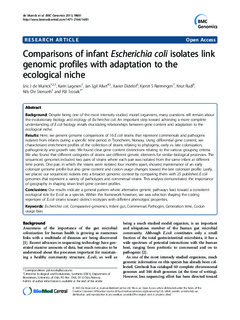| dc.contributor.author | De Muinck, Eric | |
| dc.contributor.author | Lagesen, Karin | |
| dc.contributor.author | Afset, Jan Egil | |
| dc.contributor.author | Didelot, Xavier | |
| dc.contributor.author | Rønningen, Kjersti Skjold | |
| dc.contributor.author | Rudi, Knut | |
| dc.contributor.author | Stenseth, Nils Christian | |
| dc.contributor.author | Trosvik, Pål | |
| dc.date.accessioned | 2013-12-13T12:11:07Z | |
| dc.date.accessioned | 2014-11-06T13:35:14Z | |
| dc.date.available | 2013-12-13T12:11:07Z | |
| dc.date.available | 2014-11-06T13:35:14Z | |
| dc.date.issued | 2013 | |
| dc.identifier.citation | BMC Genomics 2013;14 | nb_NO |
| dc.identifier.issn | 1471-2164 | |
| dc.identifier.uri | http://hdl.handle.net/11250/225425 | |
| dc.description.abstract | Despite being one of the most intensely studied model organisms, many questions still remain about
the evolutionary biology and ecology of Escherichia coli. An important step toward achieving a more complete
understanding of E.coli biology entails elucidating relationships between gene content and adaptation to the
ecological niche.
Here, we present genome comparisons of 16 E.coli strains that represent commensals and pathogens
isolated from infants during a specific time period in Trondheim, Norway. Using differential gene content, we
characterized enrichment profiles of the collection of strains relating to phylogeny, early vs. late colonization,
pathogenicity and growth rate. We found clear gene content distinctions relating to the various grouping criteria.
We also found that different categories of strains use different genetic elements for similar biological processes. The
sequenced genomes included two pairs of strains where each pair was isolated from the same infant at different
time points. One pair, in which the strains were isolated four months apart, showed maintenance of an early
colonizer genome profile but also gene content and codon usage changes toward the late colonizer profile. Lastly,
we placed our sequenced isolates into a broader genomic context by comparing them with 25 published E.coli
genomes that represent a variety of pathotypes and commensal strains. This analysis demonstrated the importance
of geography in shaping strain level gene content profiles.
Our results indicate a general pattern where alternative genetic pathways lead toward a consistent
ecological role for E.coli as a species. Within this framework however, we saw selection shaping the coding
repertoire of E.coli strains toward distinct ecotypes with different phenotypic properties. | nb_NO |
| dc.language.iso | eng | nb_NO |
| dc.rights | Navngivelse 3.0 Norge | * |
| dc.rights.uri | http://creativecommons.org/licenses/by/3.0/no/ | * |
| dc.subject | Escherichia coli | nb_NO |
| dc.subject | Pathogens | nb_NO |
| dc.subject | genomics | nb_NO |
| dc.subject | Infants | nb_NO |
| dc.subject | intestines | nb_NO |
| dc.title | Comparisons of infant Escherichia coli isolates link genomic profiles with adaptation to the ecological niche | nb_NO |
| dc.type | Journal article | nb_NO |
| dc.type | Peer reviewed | nb_NO |
| dc.date.updated | 2013-12-13T12:11:07Z | |
| dc.subject.nsi | VDP::Mathematics and natural science: 400::Basic biosciences: 470::Genetics and genomics: 474 | nb_NO |
| dc.identifier.doi | 10.1186/1471-2164-14-81 | |
| dc.identifier.cristin | 1039239 | |
| dc.relation.project | Norges forskningsråd: 179569 | nb_NO |

